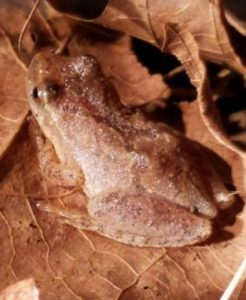Fun with Kids and Nature: Admiring Amphibians
Right here in suburban Northern Virginia, an ancient awakening occurs every year as late Winter melts into Spring. Spring peepers, wood frogs, and spotted salamanders migrate en mass to breed and lay eggs in vernal pools across the DC area in late February and March.
This is the perfect time of year to introduce children to the wonders of amphibians!
Any evening in February, March or April when the daytime temperature are at least 60 F you have the opportunity to hear the deafening calls of the tiny spring peeper frog. The best place to hear these tiny frogs is anywhere there is standing water in a field or woodlands.

Another early frog to introduce your kids to is the amazing wood frog. Wood frogs live as far north as Alaska and have the incredible ability to freeze solid, defrost, and live happily ever after. You can see these “super frogs” in the DC area in late February and early March in vernal pools. Vernal pools are basically puddles of water anywhere from a few inches to a few feet deep that fill with water in winter and dry up in summer. Since the pools typically dry up each year, fish are not able to survive in them. With no fish to eat the eggs or tadpoles, vernal pools are critical to the survival of many amphibian species.



Another, slightly more mysterious amphibian that migrates to vernal pools every spring in the beautiful spotted salamander. This chunky salamander can grow 6-8 inches long and is shiny black with bright yellow spots on its body.
Although they may appear similar in appearance to lizards, salamanders are amphibians and are quite different. First, lizards, like all reptiles, have dry scaly skin whereas salamanders have no scales and have skin covered in slimy mucous. Second, lizards lay eggs on land and like most amphibians, salamanders must lay their eggs in water.
You can often see spotted salamander adults on warm late winter evenings migrating to vernal pools across the DC region. During the day, you might spot a spotted salamander egg mass. Spotted salamander eggs are similar to wood frogs eggs, but are more tightly compacted and less “loose.”


Now that you have been introduced the world of vernal pools, grab the kids and a flashlight and head out on an awesome amphibian adventure!
And if you are looking for a fun and educational show to learn more about frogs, salamanders, and vernal pools, check out my show “Animals in Spring & Summer.”







